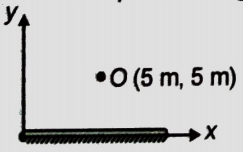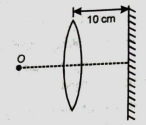A plane mirror is placed on \(x\text-z\) plane and is free to rotate about \(z\text-\)axis. A fixed object in on \(x\text-y\) plane at a point \(O(5\text{m}, 5\text{m})\). When the mirror starts rotating anticlockwise with angular speed \(5\) rad/s about \(z\text-\)axis. The initial linear speed of the image is:

1. \(25~\text{m/s}\)
2. \(25\sqrt{2}~\text{m/s}\)
3. \(50~\text{m/s}\)
4. \(50\sqrt{2}~\text{m/s}\)

1. \(25~\text{m/s}\)
2. \(25\sqrt{2}~\text{m/s}\)
3. \(50~\text{m/s}\)
4. \(50\sqrt{2}~\text{m/s}\)
An object is placed at infinite distance from a concave lens. If m is magnification obtained in the size of the image; then
(1) m=0
(2) m<<-1
(3) m>-1
(4) m<<+1
The diameter of a plano-convex lens is 5 cm and thickness at the centre is 5 mm. If the refractive index of the material of the lens is 1.5, the focal length of the lens is (approximately)
1. 13 cm
2. 15 cm
3. 20 cm
4. 6.35 cm
A point object O is placed at distance 20 cm from a biconvex lens of radius of curvature 20 cm and =1.5. The final image produced by lens and mirror combination will be at

(1) 10 cm from the mirror
(2) 20 cm from lens
(3) -20 cm from lens
(4) -15 cm from the mirror
If the angle of a triangular prism is A and the refractive index of the material is , then under what condition will there be no emergent ray?
1.
2.
3.
4.
A thin lens whose power is +2D is cut into two pieces perpendicular to the principal axis. The focal length of each part will be
(1) 1 m
(2) 0.1 m
(3) 75 cm
(4) 0.05 m
A light ray is incident at an angle of on one face of a prism of a refractive angle . If light ray grazes the second face, then the refractive index of the material of prism is-
1.
2.
3.
4.
The near point of a hypermetropic eye is \(1~\text{m}.\)What is the power of the lens required to correct this defect?
1. \(-3~\text{D}\)
2. \(+3~\text{D}\)
3. \(+1~\text{D}\)
4. \(-1.75~\text{D}\)
The minimum magnifying power of an astronomical telescope is \(40\). If the length of the telescope is \(205\) cm, then the focal length of its field lens is:
1. \(5\) cm
2. \(200\) cm
3. \(40\) cm
4. \(140\) cm
A boy with defective eye-sight cannot see things beyond 50 cm. The corrective lens required has the power:
1. +1 D
2. +2 D
3. -1 D
4. -2 D






